



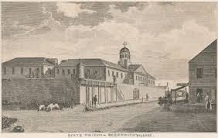

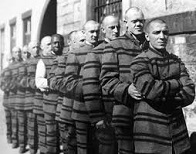
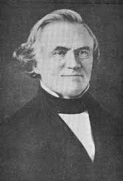
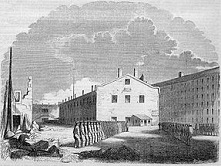
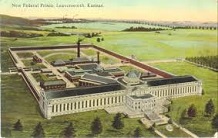
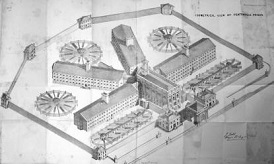
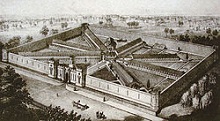
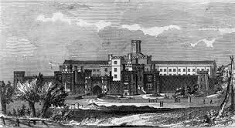


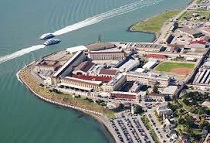
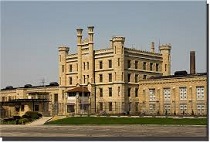
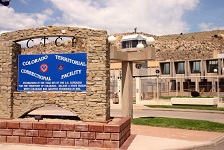


















TLW's Prisonscope™ (Prison Historyscope) |
By T.L. Winslow (TLW), the Historyscoper™ |
© Copyright by T.L. Winslow. All Rights Reserved. |
Original Pub. Date: Mar. 8, 2017. Last Update: Jan. 20, 2022. |

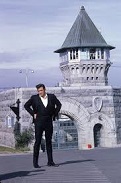

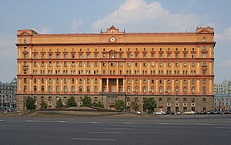
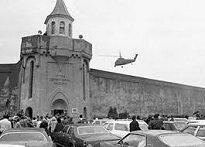

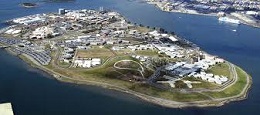

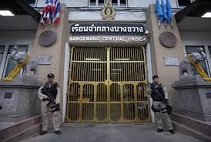

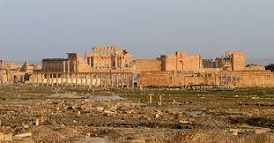

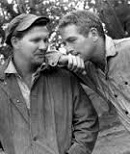
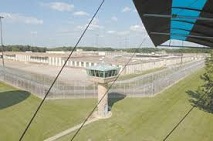
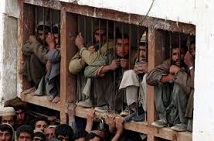
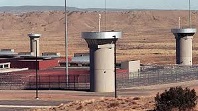
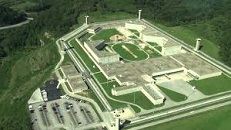
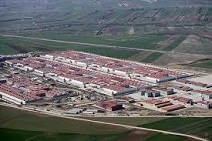
Westerners are not only known as history ignoramuses, but double dumbass history ignoramuses when it comes to prison history. Since I'm the one-and-only Historyscoper (tm), let me quickly bring you up to speed before you dive into my Master Historyscope.
In ancient times most crimes were punished with execution. The earliest prisons were usually dungeons.
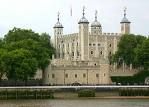
In 1078 in order to overawe the pesky Anglo-Saxon dogs, William I the Big Bad Conqueror orders the construction of the Tower of London outside the E wall of the city of London on the N Middlesex bank of the Thames River by Bishop Gundulf of Rochester as a "symbol of his power, a fortress for his defense, and a prison for his enemies"; it takes 30+ years to complete; a prophesy that when the ravens abandon it the English monarchy is supposed to fall causes seven clipped ravens to be kept there; the 90-ft. White Tower (royal residence) is built with stones from Normandy, with three square and one round turret (NE corner), and a single 2nd-story entrance on the S side reached by an external staircase; the jail is on the top, so that anybody attempting to jump better think twice; it contains a garderobe, toilet stalls facing away from the city.
In 1151 the notorious prison known as The Clink in Southwark, England next to Winchester Palace is built for the bishop of Worchester, becoming known for maltreatment of prisoners until it burns down in 1780.

In 1188 the Saladin Tithe in place, Newgate Prison in London at the corner of Newgate St. and Old Bailey just inside the city walls is built at the site of a gate of the Roman London Wall by orders of Henry II, going on to be extended and rebuilt many times until it is closed in 1902 and demolished in 1904 after becoming infamous for its unhealthy conditions.
In 1197 Fleet Prison on the E bank of the Fleet River in London is built, becoming known for housing people committed by the Star Chamber, for persons charged with contempt of court by the Court of Chancery, and as a debtor's prison; in 1381 it is destroyed by Wat Tyler's men; in 1666 it burns down on day 3 of the Great Fire of London; after it is rebuilt, it becomes known for the highest fees in England, complete with grill built into the Farringdon St. wall for prisoners to beg alms, along with Liberty of the Fleet for those who pay enough; starting in 1613 clandestine Fleet Marriages are performed; it is destroyed during the Gordon Riots of 1780; in 1842 Parliament passes an act requiring inmates of Fleet Prison and Marshalsea Prison to be moved to the Queen's Bench Prison, which is renamed the Queen's Prison; it is closed in 1844, and demolished in 1846.

In 1357 the Bastille (originally Bastille Saint-Antoine Castle) is built to protect the strategic gateway of the Port Saint-Antoine on the E side of Paris from the pesky English; construction drags along until the 1370s; in 1417 it becomes a state prison; Louis XIV uses it to imprison nobles and Huguenots; by 1789 it houses 5,279 prisoners, some of whom write autobios. complaining of bad conditions, causing reforms to be implemented and the prison pop. to be considerably reduced by the time of the July 14, 1789 Bastille Day.
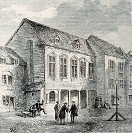
In 1373 Marshalsea Prison on Borough High St. in Southwark, London S of the Thames River is built, housing men charged with sedition and crimes at sea, growing into a debtors prison by the 18th cent., turning into an extortion racket, with those who can pay enjoying college-like amenities while the rest are herded into nine small rooms like cattle, and face starvation and torture; in 1729 a parliamentary committee finds that 300 inmates starved to death in the past 3 mo.; in 1824 Charles Dickens' father is sent there; a second prison is built in 1811; in 1842 Parliament passes an act requiring inmates of Fleet Prison and Marshalsea Prison to be moved to the Queen's Bench Prison, which is renamed the Queen's Prison.

The original I Have a Dream? In 1516 English brain man Sir (St.) Thomas More (1478-1535) pub. Utopia (Gr. "no place" - pun on "good place"); Amerigo Vespucci crewmember Ralph Hythlodaye tells about his visit to an island where land is owned in common by the snobs (with plenty of slaves for the menial work), everybody has a job, and there is universal education and religious toleration, contrasting this perfect society with the hellhole of England; it recommends penal slavery instead of death as a punishment for crimes, eventually spawning the English Poor Laws, and becomes the father of Communism?; influences Nostradamus?; since More wears an itchy-scratchy goat hair shirt for most of his life, judge it by the source?

In 1517 after claiming to see a "column of fire", St. Cyril of Novozeno founds a Russian Orthodox monastery on Ongenny Ostrov Island (Russ. "Fiery Island") on beautiful White Lake in the Vologda region of C Russia; after the Oct. 1917 Russian Rev. it is converted into a prison by the Bolsheviks, with small inhuman 2-man cells that prisoners must stay in for 22.5 hours/day.
In 1539 the first criminal court in England is established at Old Bailey on the W wall of London (destroyed in 1666).


In 1585 Old Bailey is first mentioned as the sessions house of the lord mayor and sheriffs of the city of London and of Middlesex, located next to the Newgate Gaol, funded by wealthy former mayor of London Sir Richard "Dick" Whittington (1354-1423); it burns down during the 1666 Great Fire of London, and is rebuilt in 1674, with an open court to prevent the spread of disease until 1734, when it was enclosed, leading to typhus outbreaks, with 60 dying in 1750 incl. the lord mayor and two judges; it is rebuilt again in 1774, and a 2nd courtroom added in 1824; in 1674-1834 100K+ criminal trials are held.
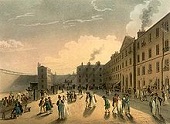
In 1758 after earlier versions burned down or were demolished in 1381, 1450, and 1761 the King's Bench Prison in St. George's Fields, Southwark, South London near Horsemonger Lane Gaol is built to house convicts of the King's Bench court, mainly convicted of defamation, bankruptcy and other misdemeanors, becoming known for dirty overcrowded conditions incl. typhus outbreaks; debtors have to provide their own food, drink, and bedding; those with money could purchase the Liberty of the King's Bench Rules, allowing them to live within a 3 m. radius; it is mentioned in Charles Dickens' novels "David Copperfield" and "Nicholas Nickleby", and in Herman Melville's novel "Billy Budd"; in 1842 it is renamed the Queen's Prison, later Southwark Convict Prison; after debtor's prisons are abolished in the 1860s, it is closed in 1880.

In 1764 Italian criminologist Cesare Beccaria (Bonesana-Beccaria), Marquis of Gualdrasco and Villaregio (1738-94) pub. On Crimes and Punishments (Tratto dei delitti e delle pene), which condemns torture and the death penalty, founding the field of Penology (Lat. "poena" + "logia" = punishment + study) along with the Classical School of Penology based on the Enlightenment, incl. Jeremy Bentham, with the slogan: "Man is a calculating animal", meaning that the punishment must fit the crime incl. being swift, which influences the U.S. Founding Fathers.




On Aug. 5, 1775 Spanish Lt. Juan Manuel de Ayala (1745-97) (who left Monterey on July 26) becomes the first Euro explorer to sail through the Golden Gate of San Francisco Bay in Calif., naming three islands incl. Alcatraz (Sp. "pelican") Island and anchoring his packet ship Punta de San Carlos (which he takes command of by luck after captain Don Miguel Manrique goes mad?) at Angel Island (Isla de Los Angeles) to wait for the overland expedition of Capt. Juan Bautista de Anza, then on Sept. 18 returns to San Blas via Monterey, telling them how the harbor beats Monterey for having less fog, and how friendly the natives are. In 1850 Pres. Millard Fillmore orders the island to be set aside as a U.S. military reservation to protect San Francisco Bay, and in 1859 Alcatraz Fortress is built, becoming a military prison in 1868. On Jan. 1, 1934 after being acquired by the U.S. Dept. of Justice last Oct. 12, Alcatraz Federal Penitentiary in San Francisco Bay officially becomes a maximum security federal prison, and after modernization it receives its first federal prisoners on Aug. 11, housing the nation's most dangerous criminals incl. Al Capone until it closes on Mar. 21, 1963. On Nov. 16, 1938 due to ill health caused by syphilis, Al Capone is released from Alcatraz Prison. On June 11/12, 1962 (night) the Big Alcatraz Escape sees IQ-133 Frank Lee Morris (1926-), John William Anglin (1930-), and brother bank robber Clarence Anglin (1931-) make the first escape from supposedly escape-proof Alcatraz federal prison in San Francisco Bay; their fate is not officially resolved (until ?), and the prison is shut down next year; on Oct. 14, 2013 three men duplicate the escape for charity.
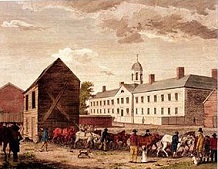
In 1776 Walnut Street Jail (Gaol) in Philadelphia, Penn. opens to receive overflow from High Street Jail, becoming the first U.S. prison with individual cells and work details; on Jan. 9, 1793 Jean-Pierre Blanchard makes the first manned balloon flight in North Am. from the prison yard in front of a crowd that incl. Pres. George Washington, Vice-pres. John Adams, Thomas Jefferson, James Madison, and James Monroe, crossing the Delaware River and making a safe landing after 45 min. in Deptford, N.J.; 1795 it is converted into Wall Street Penitentiary, pioneering the Quaker idea of combating crime via solitary confinement; it closes in 1838.
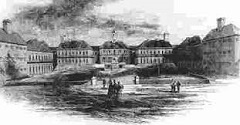
In 1778 Parkhurst Prison on the Isle of Wight is founded as a military hospital and children's asylum, becoming a children's prison by 1838, sending 123 Parkhurst apprentices to New Zealand in 1842-3, and 1,500 boys to Australia and New Zeland in 1842-9, after which it accepts adult convicts, becoming a prison for young males in 1863, known for harsh treatment; celeb prisoners incl. Yorkshire Ripper Peter Sutcliffe, the Kray twins, John Clark AKA Mr. Asia Drug Syndicate, and Moors Murderer Ian Brady.
In 1779 after the Am. Rev. closes the U.S. as a destination for transported felons, Britain passes the Penitentiary Act, drafted by jurist William Blackstone and reformer John Howard, recommending imprisonment over death or transportation, ordering the construction of a network of state-operated prisons, becoming the first; too bad, Parliament drags its feet and only creates two new prisons in London.

In 1791 English social reformer (founder of modern utilitarianism) Jeremy Bentham (1748-1832) pub. Panopticon, containing his idea of a prison where one guard can observe all the prisoners without being seen, keeping them on their toes.

In 1797 Newgate Prison opens in Greenwich Village, N.Y. at West 10th St. on the Hudson River near the Chistopher St. Pier, designed by French-born architect Joseph-Francois Mangin (1758-?), who later helps design New York City Hall; warden #1 (until 1801) is Quaker prison reformer Thomas Eddy (1758-1827), who starts out trying provide a humanitarian place for rehabiliation and watches it degenerate into an overcrowded disease-filled violent hellhole, with 817 inmates by 1821 in a bldg. designed for 432; since it's N of New York City, sentencing to it is called being "sent up the river", which carries over to Sing Sing; it closes in 1829.


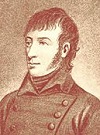
On July 23, 1803 the Society of United Irishmen, led by "the Irish Patriot" Robert Emmet (1778-1803) stage the disastrous poorly-planned Insurrection (Rebellion) of 1803 in Dublin, which is suppressed by English CIC in Ireland gen. Henry Edward Fox (1755-1811) who got rich as paymaster gen. in the Seven Years' War); on Oct. 21 United Irishmen leader Thomas Paliser Russell (1767-1803) is hanged and beheaded in Downpatrick Gaol; on Sept. 20 after telling his judges "Let no man write my epitaph", Emmett is hanged, drawn, and quartered in front of St. Catherine's Church on Thomas St. in Dublin after being held in the new Kilmainham Gaol (built 1796) in Dublin, which becomes infamous for maltreatment of prisoners, with men, women, and children not segregated and forced to live most of the time in the dark; more Irish are transported from Spike Island Prison in beautiful Cork harbor to Botany Bay to face cruel Gov. Captain William Bligh of "Mutiny on the Bounty" fame, incl. Michael Dwyer (1772-1825) of County Wicklow and his comrades Hugh Byrne, Martin Bourke and Arthur Devlin; at least the first Roman Catholic masses are permitted there by the "No Popery" Brits on the site of the future (1844) Church of St. Patrick in Sydney.

In 1816 Millbank Prison in Millbank, Pimlico, London, England opens as the British Nat. Penitentiary, used to hold prisoners slated for transportation to Australia, becoming the first modern prison; by the end of 1817 it houses 103 men and 109 women, growing to 452 and 326 women by 1822; prisoners considered likely to reform are offered 5-10 years there instead of transportation; it closes in 1890.

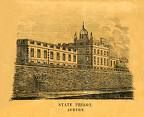


In 1818 Auburn Prison (later Auburn Correctional Facility in 1970) in Auburn, N.Y. opens on land that once housed a Cayuga village, becoming the 2nd state prison in N.Y. after Newgate, becoming known for the Auburn (New York) (Congregate) System of solitary confinement, stripey uniforms, lockstep, silence, and harsh labor in congregate workshops, created by warden #2 (1821-25) Capt. Elam Lynds (1784-1855), which he brings with him to Sing Sing in 1825-30; in 1848 the Copper John statue of an Am. Rev. War statue is mounted atop the facility; too bad, it has a big stiff dong, which is filed off in Aug. 2004; in 1890 Auburn becomes the site of the first court-ordered electrocution.
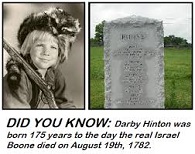
In 1821 after the name "Missouriopois" is rejected, the Mo. legislature chooses the village of Lohman's Landing on the Missouri River at the center of the state midway between St. Louis (107 mi. to the E) and Kansas City (157 mi. to the W) to replace St. Charles as the new Mo. capital under the name Jefferson City, Mo., named after Pres. Thomas Jefferson and sited by Daniel Boone's son Israel Boone (1759-82); it is it is incorporated as a city in 1825, and the legislature meets there for the first time in 1826; Mo. State Penitentiary opens there in 1836 (until 2004); the Mo. Rhineland is established in the Missouri River Valley in the mid-1800s by German immigrants, stretching from Marthasville, Mo. W to Jefferson City.

In 1826 Sing Sing Prison (Native Am. "sinck sinck" = stone upon stone), built by the N.Y. legislature in Ossining Village on Mount Pleasant in Westchester County 30 mi. N of New York City opens, employing the Auburn (New York) (Congregate) System that imposes absolute silence on prisoners enforced by whipping and brutal punishments, becoming a model prison because it turns a profit for the state; it is completed in Oct. 1828.; in 1970-85 it becomes Ossining Correctional Facility; by 1972 614 men and women are executed on death row's Old Sparky.
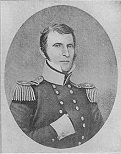

In 1827 Ft. Leavenworth is established by the 3rd Infantry Regiment under Col. (later Gen.) Henry Leavenworth (1783-1834) in NE Kansas (25 mi. NW of Kansas City) on bluffs above the Missouri River to guard wagon trains moving W on branches of the Santa Fe and Oregon Trails, which cross the river there; in 1829 the Rookery, the oldest house in Kansas is built there for the commanders, being used by the first gov. of Kansas Territory; on Sept. 21, 1866 the U.S. 10th Cavalry Regiment is formed there, becoming home of the African-Am. Buffalo soldiers; the the U.S. Disciplinary Barracks is founded in 1874, becoming the U.S. Defense Dept.'s only maximum security prison.

In 1829 Eastern State Penitentiary in Philadelphia, Penn. opens, pioneering the Separate (Penn.) System based on separation of inmates in 4-8 radiating (wagon wheel) wings of prison blocks around a central hall, with prisoners required to wear masks and work inside their cells, known as the Penn. (Separate) System, which becomes influential with other prisons; celeb prisoners incl. Al Capone and Willie Sutton; it closes in 1971.

In 1842 due to overcrowding, disease, and high costs at Millbank Prison, Pentonville Prison in Barnsbury, London, England opens to take over Millbank Prison's role as the British Nat. Penitentiary, with Millbank used only for holding prisoners for 3 mo. before being transported, reaching 4K/year by 1850-3, then tapering off until it closes in 1890; in 1902 Pentonville takes over responsibility for executions.

In 1844 Reading Gaol (HM Prison Reading) next to Reading Abbey on the Kennet River in Reading, Berkshire, England opens, utilizing the newfangled Separate System and executing its first prisoner next year before a crowd of 10K, followed by 1,867 more until 1913; celeb prisoners incl. Oscar Wilde and actor Stacy Keach.

In 1851 Charles Street (Suffolk County) Jail in Boston, Mass. opens, designed in the form of a cross with four wings holding 220 8'x10' granite cells, going on to house celeb inmates Malcolm X, and Sacco and Vanzetti along with suffragist protesters and German U-boat POWs; it closes in 1990, and is reopened in 2007 as a luxury hotel.

In July 1852 San Quentin State Prison on Point Quentin (named after Coast Miwok warrior Quentin) in Marin County, Calif. on the N side of San Francisco Bay opens, with 700 male inmates housed on death row by Dec. 2015; celeb prisoners incl. Merle Haggard, Charles Manson, actor Danny Trejo, and Sirhan Sirhan; country singer Johnny Cash holds concerts there in 1958 and Feb. 24, 1969.

In 1852 penal settlements are founded in French Guiana around the mouth of the Maroni River and the Iles de Salut, incl. lovely isolated Devil's Island, used to imprison political prisoners incl. Capt. Alfred Dreyfus (closes 1953).
On Jan. 17, 1858 the town of Canon (Cañon) City, Colo. in Fremont County on the Arkansas River in SC Colo. (modern-day pop. 16K) is laid out by people who never live there, after which in late 1859 a new party jumps their claim, putting up the first bldg. in Feb. 1860 as a commercial center for mining in South Park and the Upper Arkansas River; in 1861 the town sends two cos. of volunteers to serve with the 2nd Colo. Infantray, fighting in N.M., Okla., and Mo. until 1865; in 1862 A.M. Cassaday strikes oil 6 mi. N of town, becoming the first commerical oil well W of the Mississippi River; after gold is discovered in Cripple Creek in 1891, several smelters are built; it goes on to become the home of nine state and four federal prisons, incl. the Colo. Territorial Correctional Faciity (1871), with a Welcome sign reading "Corrections Capitol of the World"; it also calls itself the climate capital of Colo.

In 1858 Joliet (Ill. State) Penitentiary in Joliet, Ill. opens, later made famous by the 1980 film "The Blues Brothers"; it closes in 2002.
In the 1860s Kansas State Penitentiary is founded in Lansing County, Kan. in Leavenworth County; in 1990 it is renamed Lansing Correctional Facility.

In Jan. 1864 Andersonville Prison (originally named Camp Sumter) is built by the Confeds. in Sumter County, SW Ga. (40 mi. from Butler), opening in Feb. and going on to house 45K Union POWs over the next 14 mo. (until Apr. 1865), of which 12K die from Southern hospitality from exposure, disease, or starvation, not to mention those killed by sharpshooters for crossing the Dead Line around the camp.

In 1871 the Colo. Territorial Correctional Facility in Canon City, Colo. opens, becoming the first prison in Colo., housing Colo.'s death row from the 1890s to the 1990s, when it is moved to the Colo. State Penitentiary; in 2012 after a lawsuit by Aurora Chuck-E-Cheese death row prisoner Nathan Dunlap over lack of outdoor exercise facilities, death row prisoners are housed in the Sterling Correctional Facility; in 2013 Colo. Gov. John Hickenlooper grants Dunlap a temporary reprieve.
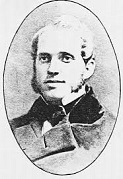
In 1876 Am. penologist Zebulon Reed Brockway (1827-1920), who tried the innovation of the indeterminate sentence in Detroit in 1861 founds the Elmira Reformatory for juveniles in upstate N.Y., the first reformatory in the U.S. with educational programs, training for trades, physical exercise, indeterminate sentences and inmate incentive programs, becoming known as "the Father of Am. Prison Reform"; too bad, before he quits in 1900 he is accused of corruption and brutality.

In 1880 Folsom State Prison in Calif. on the site of the Stony Bar mining camp on the American River 20 mi. NE of Sacramento opens, becoming known for dark stone cells; in 1895 it becomes the first prison in the U.S. with er, electricity from the new Folsom Power House; on Dec. 13, 1895 it hangs its first prisoner, followed by 92 more by Dec. 3, 1937, after which Calif. executions are transferred to the gas chamber in San Quentin; on Jan. 13, 1968 Johnny Cash performs two shows, which are released as an album, featuring the hit song "Folsom Prison Blues".

On Aug. 6, 1890 (7:00 a.m.) after Thomas Edison helps nix his appeal in hopes that the use of Westinghouse's AC rather than his DC will give them a bad name, convicted common-law wife hatchet murderer William Francis Kemmler (b. 1860) becomes the first person to be executed on an Electric Chair as N.Y. tries out its brand-new 1888 model in Auburn Prison; after being zapped for 17 sec. with 1K volts, he is still breathing, so they juice it up to 2K volts for 70 sec., during which time he catches fire and nauseated witnesses run for it, backfiring on Edison and stinking his name up bigtime, while not harming the rep of AC - the original Green Mile?
In 1891 the U.S. Three Prisons Act is passed, authorizing the first three federal penitentiaries, incl. USP Leavenworth, USP Atlanta, and USP McNeil Island, with limited supervision by the U.S. Dept. of Justice.

In 1891 New York City Presbyterian minister Charles Henry Parkhurst (1842-1933) becomes pres. of the New York Society for the Prevention of Crime, and does his alma mater Amherst College proud by finding that the pigs, er, police are in league with the criminals, many of whom are in Tammany Hall, giving a speech from the pulpit next Feb. 14 exposing them, causing an investigation in 1894 resulting in a number of police being arrested and convicted.

In 1898 the Neo-Baroque yellow-brick Lubyanka Bldg. on Lubyanka Square in Meshchansky District, Moscow, Russia is built for the All-Russia Insurance Co., designed by architect Alexander V. Ivanov; after the Oct. 1917 Russian Rev., it is taken over by the Bolshevik Cheka secret police, becoming known as the tallest bldg. in Moscow because Siberia can be seen from its basement by tortured prisoners.
In 1901 Miss. State Penitentiary, AKA Parchman Farm is founded in Sunflower County in the Miss. Delta region, becoming known for the Trusty System, which replaces convict leasing for inmate control, using designated inmates to punish other inmates; Leadbelly's song Midnight Special is about the night train that carries the prisoners' wives and girlfriends for weekend conjugal visits, supposedly shining a flashlight if they're coming with papers to free them; in 1974 a federal court rules in Gates v. Collier that it violates the 8th Amendment.
In 1908 after reports of torture of Okla. inmates, the Okla. State Penitentiary AKA Big Mac is founded in McAlester, Okla. with 100 inmates from the Kansas State Penitentiary, becoming home to an annual prison rodeo in 1940-2009, gaining fame as the pen from which Tom Joad is released in John Steinbeck's "The Grapes of Wrath" (1939); in 1915-2014 it executes 192 men and 3 women, mostly by hanging, and 82 by electrocution on Old Sparky (last in 1966); on Sept. 10, 1990 lethal injection is first used; in 2009 after female convicts are allowed to compete in the rodeo in 2006, the documentary film Sweethearts of the Prison Rodeo is released, dir. by Bradley Beesley.
In 1918 the Gulag (Russ. "main camp admin.") system of forced labor camps is set up in Russia by the Bolsheviks, and officially legalized on Apr. 15, 1919, growing to a pop. of 100K by the 1920s, with brutal conditions and a high mortality rate; in the 1930s-1950s dictator Joseph Stalin uses them to enslave and crush all real or potential political opponents; in Mar. 1940 there are 53 Gulag camps and 423 labor colonies in the Soviet Union.

In 1923 the French Mandate for Syria and Lebanon is ratified, after which in 1943 Syria and Lebanon become independent, and French troops leave them in 1946; meanwhile Tadmor (Arab. "destruction") (Palmyra) Prison 120 mi. NE of Damascus is created from a French military barracks, becoming known for brutality, torture, and summary executions; on June 27, 1980 the Tadmor Massacre sees 1K prisoners murdered by the Defense Brigades of Gen. Rifaat al-Assad after the Muslim Brotherhood almost assassinates his brother Hafez al-Assad; the prison is closed in 2001, then reopened on June 15, 2011 to house anti-govt. demonstrators; in May 2015 it is captured and blown up on May 30 by ISIS.
On Nov. 24, 1927 (11:00 a.m.) (Thanksgiving Day), a riot in Folsom Prison in Calif. begins while convicts are watching a movie in the prison schoolhouse, taking several prison guards hostage, causing Calif. gov. #26 (1927-31) C.C. Young to call out the Calif. Army Nat. Guard, which arrives with heavy machine guns and two tanks, causing the rioters to give up.
In 1930 the U.S. Federal Bureau of Prisons is established in Washington, D.C. as a subdiv. of the U.S. Dept. of Justice to administer the federal prison system consisting of 11 prisons, which expands by the end of the year to 14 prisons with 13K inmates, and by 1940 to 24 prisons with 24,360 inmates.


In the 1930s Bang Kwang Central Prison 7 mi. N of Bangkok, Thailand is founded, becoming known as "the Bangkok Hilton" and "the Big Tiger" (for eating men alive), becoming known for cruel and harsh conditions, poor food and sanitation, vermin, use of leg irons, etc., making it the world's worst prison?
On Apr. 21, 1930 a fire in Ohio State Penitentiary in Columbus kills 320 convicts, becoming Ohio's worst fire (until ?) - call it a custodial error?



In 1931 Attica Correctional Facility in Attica, N.Y. opens, housing the most dangerous criminals, with a tear gas system installed to quell riots, which doesn't stop a big one in 1971. On Sept. 9-13, 1971 after discovering racially-biased sentences and parole decisions, and hearing of the Sept. 9 shooting of San Quenin black radical prisoner George Jackson, 1.3K pissed-off prisoners seize control of the maximum-security 2.2K-inmate Attica Correctional Facility near Buffalo, N.Y., taking 33 hostages and beginning a siege that claims 43 lives (11 guards and 32 inmates, incl. 9 hostages) and injures 80+ before 1.5K state troopers, sheriff's deputies and prison guards move in and quell the rebellion early on Sept. 13; for the first days, authorities agree to 28 prisoner demands, but balk at amnesty and removal of the supt.; the final assault by the New York State Police pumps 2.5K hollow tip and deer slug bullets into a 50 yd. x 50 yd. enclosure for 10 min., creating mucho carnage; riot leader Samuel Joseph Melville (Grossman) (b. 1934) (leader of the Weather Underground, known for his 1969 bombings of blgs. in New York City, plus a Mar. 7, 1970 escape attempt at a federal courthouse) is killed; other leaders incl. Elliott "L.D." Barkley and Tommy Hicks; N.Y. gov. Nelson Rockefeller is called a murderer, becoming the worst Rockefeller criticism since the 1914 Ludlow Massacre; on Aug. 28, 2000 a federal court awards the survivors $8M, incl. $25K to Melville's son Josh Melville.

In 1932 Rikers Island on the East River between Queens, N.Y. and Bronx, N.Y. next to the runways of LaGuardia Airport (named after Abraham Rycken, who purchased it in 1664) opens as a replacement for the Welfare Island (near Roosevelt Island) Jail, with prisoners hauling ashes for landful, enlarging the site from 100 to 415 acres; it goes on to house 10K inmates and become notorious for neglect and abuse, along with prisoner attacks on staff; in May 2013 it is ranked one of the top-ten worst correctional facilities in the U.S.; in 2015 there are 9,424 assaults, with few murders.

On July 3, 1962 John Frankenheimer's Birdman of Alcatraz (United Artists) debuts, based on the 1955 book by Thomas E. Gaddis, starring Burt Lancaster as lifer IQ-134 ornithologist Robert Franklin Stroud (1890-1963), who is portrayed as an unjustly imprisoned mild-mannered scientist crushed by the cruelty of anti-scientific wardens like Harvey Shoemaker (Karl Malden) even though he killed two men, is not exactly mild mannered, and is a pedophile?; he had been kept in Alcatraz in 1942-59, when his failing health caused him to be moved to a federal prison hospital in Mo.; petitions are handed out in the theater lobbies for his release, and atty. Richard M. English takes up his cause, approaching the Kennedy admin., but he dies next year still petting his files in priz.

On Mar. 21, 1963 (first day of er, spring?) Alcatraz Federal Penitentiary in San Francisco Bay, Calif. is closed after 29 years by order of U.S. atty.-gen. Robert F. Kennedy; Marion Federal Penitentiary in Williamson County 9 mi. S of Marion, Ill. and 120 mi. SE of St. Louis, Mo. opens to replace Alcatraz Federal Penitentiary; on Oct. 22, 1983 violence forces a long-term lockdown, making it the first control unit in the U.S., with 22-23 hours/day of solitary confinement (until 2006).


On Nov. 1, 1967 Stuart Rosenberg's Cool Hand Luke (Warner Bros.) debuts, based on the 1965 chain gang novel by Donn Pearce, featuring blue-eyed 50-hard-boiled-eggs-eating ever-smirking Paul Leonard Newman (1925-2008) in the title role, George Harris Kennedy Jr. (1925-2016) as his chain gang leader buddy Dragline, and Strother Martin as the oppressive warden, with the memorable soundbyte: "What we have here is a failure to communicate"; Pearce has a cameo as a convict named Sailor; "I'm shakin' the bush, boss"; "I got my mind right, boss"; "Sometimes nothing can be a real cool hand" (Newman).
On Sept. 28, 1968 350 prisoners at Ohio State Penitentiary in Columbus riot against "sadistic guards", and 500 Nat. Guardsmen and police blast a hole in the prison wall, killing five convicts.
On Aug. 21, 1921 three prisoners and three guards are killed during an attempted prison escape at San Quentin, Calif. when, after meeting with his atty. Stephen Gingham, George Jackson (1942-) pulls a hidden automatic pistol from his "big hair".
On Oct. 16, 1972 a riot in the new Maze Prison (Her Majesty's Prison Maze) (originally Long Kesh Detention Centre) (opened Aug. 9, 1971) in County Down, Northern Ireland for paramilitary prisonres results in a fire burning most of the camp.
On July 27-29, 1973 the 1973 Okla. State Penitentiary Riot ends with three inmates killed, 21 inmates and guards injured, 12 blgs. burned, and $30M damage, causing U.S. district judge Luther Bohannon to put the Okla. Dept. of Corrections under federal control.

On Oct. 6, 1978 Alan Parker's Midnight Express (Casablanca Filmworks) (Columbia Pictures) debuts, written by Oliver Stone based on the 1977 book by Billy Hayes and filmed in Malta, starring Brad Davis as young Am. student Billy Hayes, who on Oct. 6, 1970 is caught smuggling hashish out of Turkey, and gets 30 years, ending up in one of their hellhole prisons, finally escaping on Oct. 4, 1975; does $35M box office on a $2.3M budget; goes too far in portraying the Turkish culture as subhuman?; the rumping-ranging warden is played by Paul L. Smith, and in real life Hayes didn't kill him; the cool Midnight Express Theme is by Giorgio Moroder.

On June 22, 1979 Don Siegel's Escape from Alcatraz (Paramount Pictures) debuts, based on the 1963 J. Campbell Bruce book about the 1962 Big Escape from Alcatraz, starring Clint Eastwood as Frank Morris, who duels with the warden (Patrick McGoohan) while planning his escape with fellow prisoners Clarence Anglin (Jack Thibeau) and John Angln (Fred Ward); film debut of Danny Glover; does $43M box office on an $8M budget.
On Feb. 2-3, 1980 overcrowded New Mexico State Penitentiary S of Santa Fe riots, taking 12 officers hostage, leaving 33 inmates killed (some of ODs), and 200+ wounded (100+ seriously) by fellow prisoners, along with $25M property damage.
On May 7, 1980 Paul Geidel (1894-1987), convicted of 2nd deg. murder is released from prison in Beacon, N.Y. after 68 years 245 days, the longest time served by a U.S. inmate (until ?), with the soundbyte "No publicity please"; he spends the rest of his life in a nursing home in Dutchess County, N.Y.

In 1980 after the Sept. 12 coup suspends the constitution and civil rights, Diyarbakir Prison in Diyarbakir, SE Turkey is founded, becoming known as "the Hell of Diyarbakir", with systematic torture killing 34 prisoners in 1981-4, mainly Kurds.
On Jan. 25, 1981 New York City cocaine dealer Robert Wyler (1938-) unsuccessfully attempts to escape from a federal jail in Manhattan via a heli commandeered by two accomplices, but after failing to break through a wire mesh on the roof they surrender, and on Sept. 25 they are convicted of air piracy and receive life sentences on top of the 24-year sentence of Wyler.
On Oct. 22, 1983 two handcuffed inmates at the federal prison in Marion, Ill. kill two guards in separate incidents, leading to permanent lockdown and the beginning of the ADX (admin. maximum) prison.
On May 31, 1984 six inmates escape from the Mecklenburg Correctional Center near Boydton in Mecklenburg County, Va. (founded 1976), becoming the first escape from a U.S. death row.
On Oct. 12, 1984 the U.S. Comprehensive Crime Control Act of 1984 is signed by Pres. Ronald Reagan, becoming the first comprehensive U.S. criminal code revision since the early 1900s; it reinstitutes the federal death penalty, provides for civil forfeiture of assets of organized crime, and incl. the U.S. Sentencing Reform Act, standardizing criminal sentences, but on the highest of high sides, eliminating parole and leaving judges no individual discretion, causing many shocking injustices; it also incl. the U.S. Armed Career Criminal Act is also passed, providing sentence enhancements for felons committing crimes with firearms with a three strikes provision; the net result is a doubling of the federal prison pop.
On Oct. 27, 1986 after giving a TV address on Sept. 14 along with his wife Nancy, Pres. Reagan signs the U.S. Anti-Drug Abuse Actof 1986 , which appropriates $1.7B to fight the drug trade, establishes mandatory sentences, and leads to a too-black prison pop. because of the disparity in sentencing between crack and powder cocaine; on Nov. 18, 1988 the U.S. Anti-Drug Abuse Act of 1988 makes it worse; the 2010 U.S. Fair Sentencing Act reduces but doesn't eliminate the disparity - the perfect Republican program?

On Sept. 10, 1994 Frank Darabont's The Shawshank Redemption (Castle Rock Entertainment) (Columbia Pictures) debuts, based on Stephen King's 1982 novella "Rita Hayworth and the Shawshank Redemption", starring Tim Robbins as bank vice-pres. Andy Dufresne, who is framed for murder and sentenced to the "toughest prison in the Northeast", Shawshank State Penitentiary in Maine, where he meets new best friend Ellis Boyd "Red" Redding (Morgan Freeman) and cooks the books for corrupt Bible-thumping warden Samuel Norton (Bob Gunton) before escaping with the dough to a life of ease after almost 30 years of surviving brutality and homosexual rape while tunneling with a rockhound hammer in his cell behind a poster of Rita Hayworth; does $58M box office on a $25M budget; "Fear can hold you prisoner, hope can set you free."

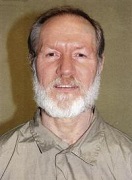
In Nov. 1994 after Aryan Brotherhood leader Thomas Edward "Terrible Tom" "Tommy" Silverstein (1952-) proves too much for the guards at Marion Federal Penitentiary in Ill., Florence Supermax Federal Penitentiary (AKA ADX Florence) in Fremont County, Colo. opens for men only, becoming known as "the Alcatraz of the Rockies", breaking prisoners with complete isolation.
On Aug. 5, 1997 the U.S. Nat. Capital Revitalization and Self-Government Improvement Act of 1997 attempts to reform the Washington, D.C. criminal justice system, ordering the Lorton Reformatory in Va. to close by Dec. 31, 2001 while transferring 6.5K prisoners from the District of Columbia around the U.S. and having the U.S. atty. gen. appoint a corrections trustee for oversight.
In 1998 the $180M Upstate Correctional Facility in Malone, Franklin County, N.Y. is built, becoming the first supermax prison in N.Y. state, housing 1.3K inmates, later becoming the home of celeb criminal Ralph "Bucky" Phillips.
On June 10, 2000 eight guards at Corcoran State Prison in Calif. are acquitted of civil rights violations for allegedly staging gladiator-style fights among inmates.

In 2003 Big Sandy Federal Penitentiary near Inez in E Ky. 133 mi. from Frankfort and 320 mi. from Washington, D.C. opens to house people convicted of crimes in Washington, D.C., becoming known for prisoner stabbings.
On Jan. 1, 2005 a prison riot at Bayside State Prison in Leesburg, N.J. by the Bloods street gang begins after guards confiscate contraband chicken from convicted 25-y.-o. drug dealer Omar McCray, and he yells, "Bloods out, rat-a-tat, Bloods out".
In 2006 Eglin Federal Prison Camp at Eglin AFB in Fla. closes after gaining the nickname "Club Fed" for being too cushy.
On Apr. 20, 2008 a riot in Florence Supermax Prison near Canon City, Colo. started by white supremacists in honor of Hitler's birthday kills two.
On July 20, 2008 Colo. Spam King Eddie Davidson (b. 1973) walks away from a federal prison camp near Florence, Colo., and on July 24 shoots his wife and child and wounds a teenage girl before killing himself near his home in Bennett, Colo.

In 2008 Silivri Prison in Silivri, Istanbul opens, becoming Turkey's most modern penal facility, and Europe's largest, housing 11K of Istanbul's 16K inmates under pink roofs.
On Aug. 8, 2009 a riot by 1.3K of 5.9K inmates at overcrowded Chino Prison 40 mi. E of Los Angeles, Calif. sparked by racial tensions between blacks and Latinos injures almost 200 inmates; a federal 3-judge panel ordered Calif. to reduce prison pop. less than 2 weeks earlier.
On Apr. 4, 2010 a jailbreak in Reynosa, Mexico near the U.S. border sees 13 inmates escape, becoming the 2nd mass jailbreak in Tamaulipas state in less than two weeks; meanwhile Mexican drug lord Ismael "El Mayo" Zambada, says that the Mexican govt. cannot win the drug war because millions of people are involved in the drug business.
On Jan. 4, 2012 a prison fight in Altamira Prison in Ciudad Victoria, Mexico kills 31.
On Feb. 21-22, 2012 a riot at Kerobakan Prison in Bali, Indonesia ends with two prisoners injured.
On Mar. 29, 2012 a prison riot in San Pedro Sula Prison in Honduras kills 13.
On May 9, 2015 a riot-jailbreak in Khalis, Iraq 40 mi. N of Baghdad kills 12 policemen and 50+ prisoners, allowing 200+ to escape.
On July 14, 2015 Pres. Obama gives a speech on prison reform at the annual NAACP convention in Philly, calling for reductions in overcrowding, gang activity, solitary confinement, and rape, uttering the soundbyte that the $80B a year spent on prisons could be used to "provide universal preschool for every 3-year-old and 4-year-old in America, double the salary of every high school teacher in America, finance new roads, bridges, and airports, job training programs, research and development, eliminate tuition at every one of our public colleges and universities."
On July 16, 2015 Pres. Obama becomes the first U.S. pres. to visit a prison while in office, El Reno Federal Correctional Inst. near Oklahoma City, Okla., uttering the soundbyte that the inmates are people "who made mistakes that aren't that different than the mistakes I made"; he enters Cell No. 123, commenting "Three full-grown men in a 9 x 10 cell."
In Jan. 2017 the U.S. Bureau of Prison begins banning all pork products from the menus of federal prisons - I bet it wasn't to please Jews and vegetarians?